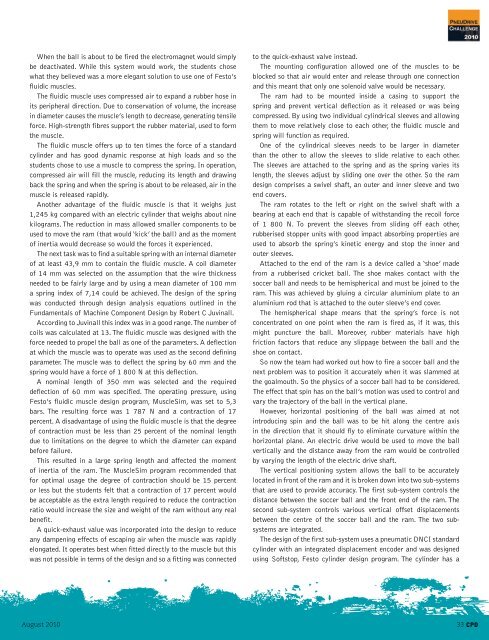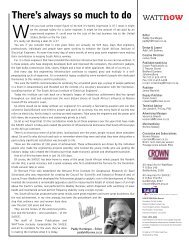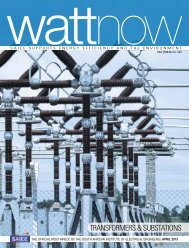download a PDF of the full August 2010 issue - Watt Now Magazine
download a PDF of the full August 2010 issue - Watt Now Magazine
download a PDF of the full August 2010 issue - Watt Now Magazine
- No tags were found...
You also want an ePaper? Increase the reach of your titles
YUMPU automatically turns print PDFs into web optimized ePapers that Google loves.
When <strong>the</strong> ball is about to be fired <strong>the</strong> electromagnet would simplybe deactivated. While this system would work, <strong>the</strong> students chosewhat <strong>the</strong>y believed was a more elegant solution to use one <strong>of</strong> Festo’sfluidic muscles.The fluidic muscle uses compressed air to expand a rubber hose inits peripheral direction. Due to conservation <strong>of</strong> volume, <strong>the</strong> increasein diameter causes <strong>the</strong> muscle’s length to decrease, generating tensileforce. High-strength fibres support <strong>the</strong> rubber material, used to form<strong>the</strong> muscle.The fluidic muscle <strong>of</strong>fers up to ten times <strong>the</strong> force <strong>of</strong> a standardcylinder and has good dynamic response at high loads and so <strong>the</strong>students chose to use a muscle to compress <strong>the</strong> spring. In operation,compressed air will fill <strong>the</strong> muscle, reducing its length and drawingback <strong>the</strong> spring and when <strong>the</strong> spring is about to be released, air in <strong>the</strong>muscle is released rapidly.Ano<strong>the</strong>r advantage <strong>of</strong> <strong>the</strong> fluidic muscle is that it weighs just1,245 kg compared with an electric cylinder that weighs about ninekilograms. The reduction in mass allowed smaller components to beused to move <strong>the</strong> ram (that would ‘kick’ <strong>the</strong> ball) and as <strong>the</strong> moment<strong>of</strong> inertia would decrease so would <strong>the</strong> forces it experienced.The next task was to find a suitable spring with an internal diameter<strong>of</strong> at least 43,9 mm to contain <strong>the</strong> fluidic muscle. A coil diameter<strong>of</strong> 14 mm was selected on <strong>the</strong> assumption that <strong>the</strong> wire thicknessneeded to be fairly large and by using a mean diameter <strong>of</strong> 100 mma spring index <strong>of</strong> 7,14 could be achieved. The design <strong>of</strong> <strong>the</strong> springwas conducted through design analysis equations outlined in <strong>the</strong>Fundamentals <strong>of</strong> Machine Component Design by Robert C Juvinall.According to Juvinall this index was in a good range. The number <strong>of</strong>coils was calculated at 13. The fluidic muscle was designed with <strong>the</strong>force needed to propel <strong>the</strong> ball as one <strong>of</strong> <strong>the</strong> parameters. A deflectionat which <strong>the</strong> muscle was to operate was used as <strong>the</strong> second definingparameter. The muscle was to deflect <strong>the</strong> spring by 60 mm and <strong>the</strong>spring would have a force <strong>of</strong> 1 800 N at this deflection.A nominal length <strong>of</strong> 350 mm was selected and <strong>the</strong> requireddeflection <strong>of</strong> 60 mm was specified. The operating pressure, usingFesto’s fluidic muscle design program, MuscleSim, was set to 5,3bars. The resulting force was 1 787 N and a contraction <strong>of</strong> 17percent. A disadvantage <strong>of</strong> using <strong>the</strong> fluidic muscle is that <strong>the</strong> degree<strong>of</strong> contraction must be less than 25 percent <strong>of</strong> <strong>the</strong> nominal lengthdue to limitations on <strong>the</strong> degree to which <strong>the</strong> diameter can expandbefore failure.This resulted in a large spring length and affected <strong>the</strong> moment<strong>of</strong> inertia <strong>of</strong> <strong>the</strong> ram. The MuscleSim program recommended thatfor optimal usage <strong>the</strong> degree <strong>of</strong> contraction should be 15 percentor less but <strong>the</strong> students felt that a contraction <strong>of</strong> 17 percent wouldbe acceptable as <strong>the</strong> extra length required to reduce <strong>the</strong> contractionratio would increase <strong>the</strong> size and weight <strong>of</strong> <strong>the</strong> ram without any realbenefit.A quick-exhaust value was incorporated into <strong>the</strong> design to reduceany dampening effects <strong>of</strong> escaping air when <strong>the</strong> muscle was rapidlyelongated. It operates best when fitted directly to <strong>the</strong> muscle but thiswas not possible in terms <strong>of</strong> <strong>the</strong> design and so a fitting was connectedto <strong>the</strong> quick-exhaust valve instead.The mounting configuration allowed one <strong>of</strong> <strong>the</strong> muscles to beblocked so that air would enter and release through one connectionand this meant that only one solenoid valve would be necessary.The ram had to be mounted inside a casing to support <strong>the</strong>spring and prevent vertical deflection as it released or was beingcompressed. By using two individual cylindrical sleeves and allowing<strong>the</strong>m to move relatively close to each o<strong>the</strong>r, <strong>the</strong> fluidic muscle andspring will function as required.One <strong>of</strong> <strong>the</strong> cylindrical sleeves needs to be larger in diameterthan <strong>the</strong> o<strong>the</strong>r to allow <strong>the</strong> sleeves to slide relative to each o<strong>the</strong>r.The sleeves are attached to <strong>the</strong> spring and as <strong>the</strong> spring varies itslength, <strong>the</strong> sleeves adjust by sliding one over <strong>the</strong> o<strong>the</strong>r. So <strong>the</strong> ramdesign comprises a swivel shaft, an outer and inner sleeve and twoend covers.The ram rotates to <strong>the</strong> left or right on <strong>the</strong> swivel shaft with abearing at each end that is capable <strong>of</strong> withstanding <strong>the</strong> recoil force<strong>of</strong> 1 800 N. To prevent <strong>the</strong> sleeves from sliding <strong>of</strong>f each o<strong>the</strong>r,rubberised stopper units with good impact absorbing properties areused to absorb <strong>the</strong> spring’s kinetic energy and stop <strong>the</strong> inner andouter sleeves.Attached to <strong>the</strong> end <strong>of</strong> <strong>the</strong> ram is a device called a ‘shoe’ madefrom a rubberised cricket ball. The shoe makes contact with <strong>the</strong>soccer ball and needs to be hemispherical and must be joined to <strong>the</strong>ram. This was achieved by gluing a circular aluminium plate to analuminium rod that is attached to <strong>the</strong> outer sleeve’s end cover.The hemispherical shape means that <strong>the</strong> spring’s force is notconcentrated on one point when <strong>the</strong> ram is fired as, if it was, thismight puncture <strong>the</strong> ball. Moreover, rubber materials have highfriction factors that reduce any slippage between <strong>the</strong> ball and <strong>the</strong>shoe on contact.So now <strong>the</strong> team had worked out how to fire a soccer ball and <strong>the</strong>next problem was to position it accurately when it was slammed at<strong>the</strong> goalmouth. So <strong>the</strong> physics <strong>of</strong> a soccer ball had to be considered.The effect that spin has on <strong>the</strong> ball’s motion was used to control andvary <strong>the</strong> trajectory <strong>of</strong> <strong>the</strong> ball in <strong>the</strong> vertical plane.However, horizontal positioning <strong>of</strong> <strong>the</strong> ball was aimed at notintroducing spin and <strong>the</strong> ball was to be hit along <strong>the</strong> centre axisin <strong>the</strong> direction that it should fly to eliminate curvature within <strong>the</strong>horizontal plane. An electric drive would be used to move <strong>the</strong> ballvertically and <strong>the</strong> distance away from <strong>the</strong> ram would be controlledby varying <strong>the</strong> length <strong>of</strong> <strong>the</strong> electric drive shaft.The vertical positioning system allows <strong>the</strong> ball to be accuratelylocated in front <strong>of</strong> <strong>the</strong> ram and it is broken down into two sub-systemsthat are used to provide accuracy. The first sub-system controls <strong>the</strong>distance between <strong>the</strong> soccer ball and <strong>the</strong> front end <strong>of</strong> <strong>the</strong> ram. Thesecond sub-system controls various vertical <strong>of</strong>fset displacementsbetween <strong>the</strong> centre <strong>of</strong> <strong>the</strong> soccer ball and <strong>the</strong> ram. The two subsystemsare integrated.The design <strong>of</strong> <strong>the</strong> first sub-system uses a pneumatic DNCI standardcylinder with an integrated displacement encoder and was designedusing S<strong>of</strong>tstop, Festo cylinder design program. The cylinder has a<strong>August</strong> <strong>2010</strong> 33
















